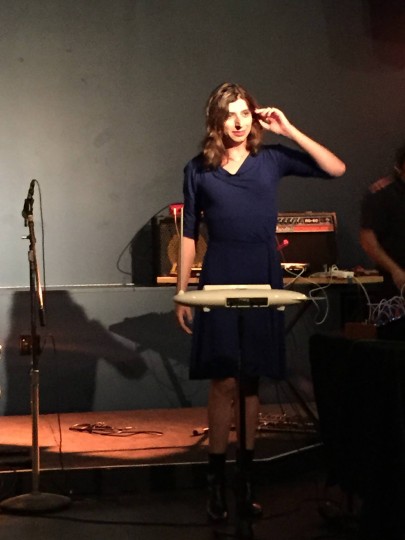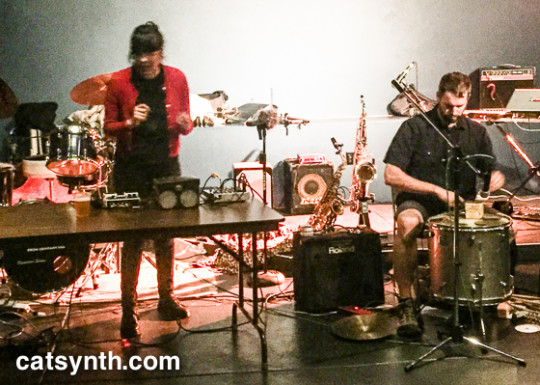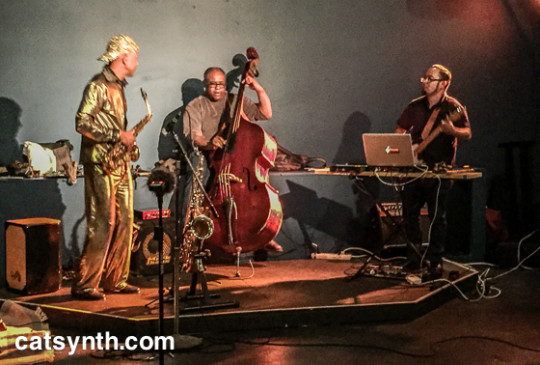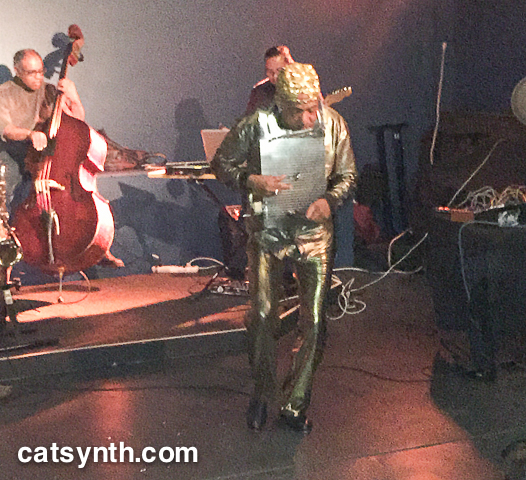This past week Polly Moller and I brought our duo Ode to Steengo to Spectrum in New York, part of a rich night of experimental acoustic and electronic music in the Ambient-Chaos series.
The evening began with an acoustic brass duo featuring Torben Snekkestad on trumpet with David Whitwell on trombone.

The two engaged in a very musical exploration of the extended timbres of these instruments. Indeed, I was quite captivated by the sounds of Whitwell’s drones and multiphonics, which sounded more like my Minimoog than a concert brass instrument. His use of a single-reed mouthpiece within the trombone’s mouthpiece was likely part of how he achieved these sounds. The pair also included sections with percussive pops and very quiet tones.
The duo was followed by the Jazzfakers, featuring Robbert Pepper on violin and electronics, David Tamura on saxophone and electronics, Raphael Zwyer on bass and Steve Orbach on drums.

Before they start playing, they look like they could be a conventional jazz quartet, but once they start one realizes they are anything but that. Their energetic performance flowed between free improvisation, electronic noise, and more familiar rhythmic and harmonic hooks. What started as a thick noise drone quickly moved to frenetic fast-moving notes from all four performers, and then hit textures in between. They are also a lot of fun to watch.
And then it was time for us to take the stage. Ode to Steengo is a piece based on spoetry (spam poetry) derived from Harry Harrison’s “Stainless Steel Rat” series. Polly Moller and I performed it several times as an electro-acoustic duo in 2008 and 2009, and then later in our band Reconnaissance Fly. We have since reprised the piece as a duo a few times. We jokingly called this version “Steengo takes Manhattan.”

[Photo by BC]
This performance was quite sparse, both in comparison to previous instances and to the Jazzfakers’ set that preceded us. But we were able to get quite a few interesting textures, some liquidy sounds from the analog modular controlled by the Moog Theremini, Polly’s flute and chanter, and a bit of live processing with a rather temperamental analog filter. As always, we try to bring a bit of wit and irreverence to our experimental music. You can here our full performance on this video.
Amanda Polly duo at Spetrum, 11-24-2014 from CatSynth on Vimeo.
Overall, it went well. We had a great time performing and we received a warm response from our New York audience.
We were followed by alphamale, a solo electronic-and-viola project.

Her set started off as a thick drone of electronics. After a time, she began to incorporate the viola as well. Overall the texture remained one of long tones and ambient sounds. It was once again a contrast to our set and the others that preceded us, and quite pretty to listen to. At times it had a dark sound – it is hard to discern if the melancholy was truly in the sound or part of a built-in set of expectations around the viola. Nonetheless, it was nice to see someone using this instrument in a solo electronic setting.
The final set of the evening featured Rawmean, another solo set, this time with guitar and electronics.

Very quickly, it was clear that this was more of a beat-and-grove set, with thick layers of guitar. The guitar work was interesting in that he was doing quick staccato motions but producing thick droning chord pads via the connected effects. The grooves and rhythmic patterns were fun, veering between straight 4/4 rhythms and the occasional odd times. Overall, the texture did remain quite constant, with a steady stream of beats that periodically changed. As I sometimes have suggested in these reviews, some sets that contain otherwise engaging material are better when shorter, and I think this was one of those instances.
Five sets in an evening is a lot, but overall we kept things moving. We had a good turnout for the first three sets, with a bit tapering off for the last two. But it was a diverse and rewarding evening of new music, and we were grateful to be a part of it. Thanks to my friends Robert Pepper (PAS) and Mike Durek (The Use) for putting this show together, and as always to Glenn Cornett of Spectrum for providing this venue for new and visiting avant-garde musicians.




































